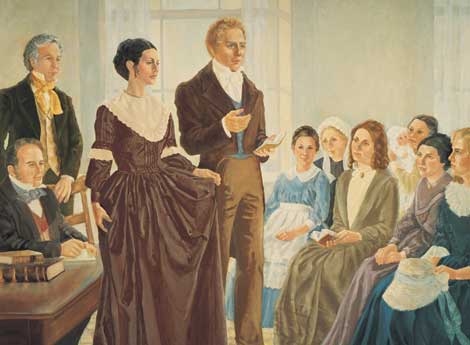
by Judy Curtis
Reading through the suggestions to empower LDS women on a document entitled All Are Alike Unto God caused me to consider how women could be transitioned into functioning in a priesthood capacity in the Church without upsetting the system more than a lot of people could handle. Here are my ideas.
First, restore the Relief Society to quorum status as it was when Joseph organized the group. When the women in Nauvoo told Joseph they wanted to form a benevolent society similar to others of the day, he said he had something better for them.
“The Society should move according to the ancient priesthood… [I will] make of this society a kingdom of priests as in Enoch’s day–as in Paul’s day… [I am] glad to have the opportunity of organizing the women, as a part of the priesthood belongs to them.”
From the minutes of the first meeting comes this quote:
“My dear sisters, the purpose of this meeting today is the making complete the organization of the church by organizing the women after the manner of the Priesthood… I propose that you sisters elect a presiding officer to preside over you and let that presiding officer choose two counselors to assist in the duties of her office. I will ordain them to preside over the society and let them preside just as the Presidency presides over the church. And if they need my instruction, ask me and I will give it from time to time… If any officers are wanted to carry out the designs of the Institution, let them be appointed and set apart as Deacons, Teachers, etcetera are among us. “
Emma was “ordained” as president. Later leaders changed the terminology to “set apart.” And indeed, women were part of The Holy Order until Joseph’s death when Brigham Young disbanded the Relief Society for ten years and reorganized it without reference to quorum or priesthood.
With the Relief Society as a quorum, the office of president would be equivalent to a bishop’s calling or Stake President’s calling. Relief Society presidents already function as bishops. (I know, I have been one three times.) The actual day to day operations and interaction would not change that much. Women would be acting with authority and it would not upset those who couldn’t deal with a female bishop because there would still be the male bishop as well. Young Women and Primary callings would also be priesthood callings. The Young Women’s organization would have to be adapted so that, like the Young Men, they would be ordained to function in the priesthood from the age of twelve just as the Young Men are.
Perhaps this would not be something new, but a return to how things were in the beginning. What are your reactions to this approach?






11 Responses
Thanks for sharing these original sources that describe the early Relief Society as “a kingdom of priests” as in former times. This historical background may help “justify” ordaining women, but “returning to how things were in the beginning” has the unfortunate side-effect of still being separate (while trying to be equal).
As you suggest, some people would be more comfortable dealing with male bishop or woman relief society president, but as long as the former presides over the latter, there is no equality. In the world around us, we are getting used (slowly but surely) to having women as top leaders in business and government, and I have faith that church members could make that adjustment as well.
Judy, thanks for this terrific post. The minutes of the first Relief Society meetings in Nauvoo are pretty radical. They indicate to me that Joseph Smith had a much more expansive and autonomous vision for Relief Society than the one our current leaders do.
Your thinking on this subject is intriguing. I think I read you saying that we should acknowledge women’s priesthood, and Relief Society as a priesthood quorum, but that day to day functions in the Church wouldn’t change that much. I think you’re right that that would be a way to ease people in to greater equality without raising too much anxiety. Over time, I would hope that women could take on more leadership roles and duties. I’d love for the RS president and her counselors to sit up on the stand with the men in sacrament meeting. I’d love for women to be able to confess to and counsel with the RS president. I’d love for he to have more say in ward goals, sacrament meeting planning, callings, etc. Eventually, I’d love for women to be performing rituals. We might be able to work towards all that with your framework.
Judy, I love this. It’s very much in line with how I think women’s ordination will eventually happen: restoring the status as quorum first, giving the same deference to female leaders as we do to male leaders, ordaining young women to the priestesshood…and then, when everyone’s used to it because it isn’t all that different from what we have now, taking the next step and integrating the two. (And I hope some of this timeline falls in the next 50 years.)
50 years! You may be right, Libby, but I fear in that time frame we will lose two generations of women who refuse to accept inequality, and those who remain will be satisfied with the status quo and might not even want equality.
My reaction concerns membership in RS versus priesthood ordination. While much of the priesthood advancement is automatic, there are still interviews and ordinations. RS membership is just by virtue of being an adult female. I think part of the strength of the old RS is that the members wanted to be a part, rather than simply being assigned to membership by nature.
Excellent post! Separate or not this would go a long way if let them preside just as the Presidency presides over the church were to take place!
Great ideas Judy. I have had similar thoughts for awhile…one in particular has intrigued me that I would appreciate input on. What if a male and female were called together as a Co-bishops. A married couple working together if they were married or if not married a single brother and single sister called to work together. I see so many benefits with this structure, including being able to call a female councilor into the bishopric enabling female clerks to be called. I love the idea of male and female overseeing and counselling together for the benefit of the congregation. It would then be so simple to put into practice many of the ideas stated in the post and in other great posts addressing this issue.
Thoughts?
Yes, I have thought of this approach before. It would probably mean older couples would be called because it would be too much for younger couples with kids. But then calling councilors, and others of both sexes to organizational jobs would be feasible. Of course, when it does actually happen it will come from the top down hopefully through revelation and the best way will be the result. We just have to keep believing it will indeed happen.
I have heard the story about how RS came about many times, but never knew that words like ordain and deacon had been used. This is fascinating.
I enjoyed that, Judy. Thanks for sharing.
I love the All Are Alike Unto God document, and I notice that the church has already (more or less) accomplished one of the items on the list: equalizing missionary ages.
It is clear to me that women can and do hold the priesthood and can lead the church in any way men can. I look forward to the hopefully-not-too-distant day when we have female prophets and apostles, stake presidents, and bishops. Brother Joseph would surely approve.